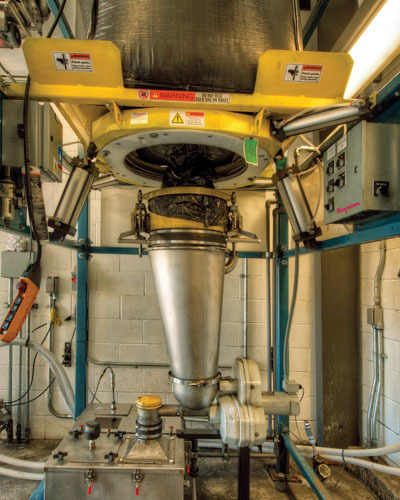Automated PAC bag discharge improves water plant safety
Monday, 17 February, 2014
Just west of Denver, Colorado, and just east of the Front Range of the Rocky Mountains is a sprawling suburban area of roughly 67 km2 that includes the cities of Lakewood and Wheat Ridge as well as unincorporated areas of Eastern Jefferson County. The water supply for the area’s population of 85,000 is served by Consolidated Mutual Water (www.cmwc.net). With approximately 523 km of pipeline, Consolidated Mutual Water purchases about two thirds of the water delivered from the Denver Water Board, with the balance stored in reservoirs and treated at the Maple Grove Water Treatment Plant.
Until recently, operators at the treatment plant were feeding powdered activated carbon (PAC) from 20 kg bags. The addition of PAC is an important step in the water treatment process - to adsorb and remove any dissolved organic contaminants that could cause unwanted tastes and odours.
Chuck Conway, a Maple Grove Water Treatment Plant operator, says that the operators used to carry 20 kg bags up a flight of stairs and manually dump them into a storage hopper above a feeder.
“It was messy, potentially dangerous and prone to generating dust. The problem became especially severe during periods of peak consumption, when we might have to add as many as 20 bags of PAC per day,” said Conway.
To solve the problem, Consolidated Mutual Water installed an automated bulk bag discharger system from Flexicon Corporation.
“We now receive PAC in 408 kg bulk bags that we unload with a bulk bag discharger so our operators no longer need to carry them. A secure seal between the bulk bag and the feeder almost completely eliminates dust,” said Conway.
The service area for the treatment plant receives an average of only 38 cm of moisture in the form of rain and snow per year, and the summer irrigation season, from May through September, is the peak time for water usage. “In fact, the same amount of water is treated and consumed during June through August as during the other 9 months of the year combined,” said Conway.
The amount of PAC added also varies according to the types of organisms involved. Some require only a 4-5 mg/L dose for effective control, while others may require 30-40 mg/L.
Since powdered activated carbon is a fine powder with an average particle size of 20 microns and a bulk density of 34.4 kg/m3, the slightest breeze can spread carbon dust everywhere. By automating the bag discharge process, Consolidated Mutual Water not only eliminated dust and operator safety problems, but also increased efficiency by freeing operators to perform more productive tasks.
The bulk bags are emptied by a Flexicon Bulk-Out BFC model discharger, which consists of a rigid frame with a cantilevered I-beam and an electric hoist and trolley. The operator places the bulk bag on the floor from a pallet truck and activates the electric hoist to insert the bag onto the discharger frame. With the bag secured on the discharger, the operator pulls the bag spout, positioned directly above a twin-screw volumetric feeder, through a Power-Cincher flow control valve that cinches the bag spout.

Below the flow control valve is a manual Spout-Lock clamp ring that is raised by a Tele-Tube telescoping tube for a dust-tight connection to the bag spout. With the connection secure, the operator unties the drawstring and opens the flow control valve to initiate flow. The telescoping tube then lowers, applying continual downward tension to keep the spout taut as the bag empties and elongates. At the same time, Flow-Flexer bag activators raise and lower the bottom edges of the bag, directing material into the outlet spout and raising the bag into a steep ‘V’ shape to promote complete total discharge into the volumetric feeder.
“We have an inline scale between the bag and the hoist, with a remote readout that allows the operator to ascertain how much PAC remains in the bag to anticipate bag changes. Eventually, we plan to run a signal transmission line into the plant so we can take this reading in the operations control centre.”
The feeder meters PAC into a two-stage tank, where it is mixed with water to form the slurry that feeds the treatment process.
The Maple Grove facility is currently designed to produce up to 56.8 ML per day, expandable to 68.1 ML per day. At a treatment rate of 30 mg/L, this requires up to 1700 kg of PAC daily, while the higher volume will require about 2043 kg. “As the population of our service area continues to increase, we are projecting as many as five bulk bags per day eventually, but our bulk transfer system will be able to handle that easily,” says Conway.
Women in automation: Ella Shakeri
On International Women's Day 2024, Swisslog System Design Engineer Ella Shakeri is...
Keeping manufacturing and distribution on track
RFID systems can help revolutionise the way a business tracks goods and manages inventory.
Tracking software for pallets, containers and more
Pallets, crates, containers, racks and tanks often remain unattended in warehouses for days,...












